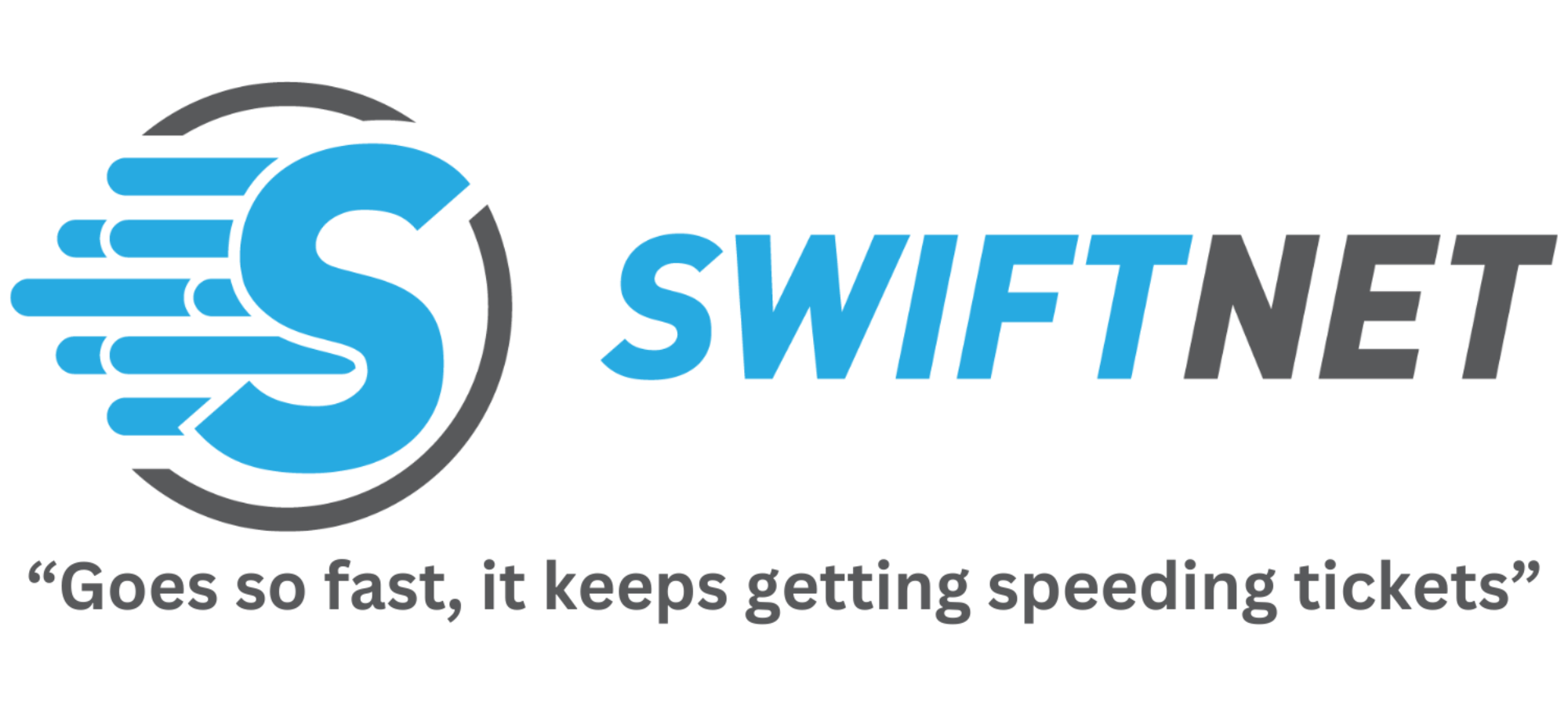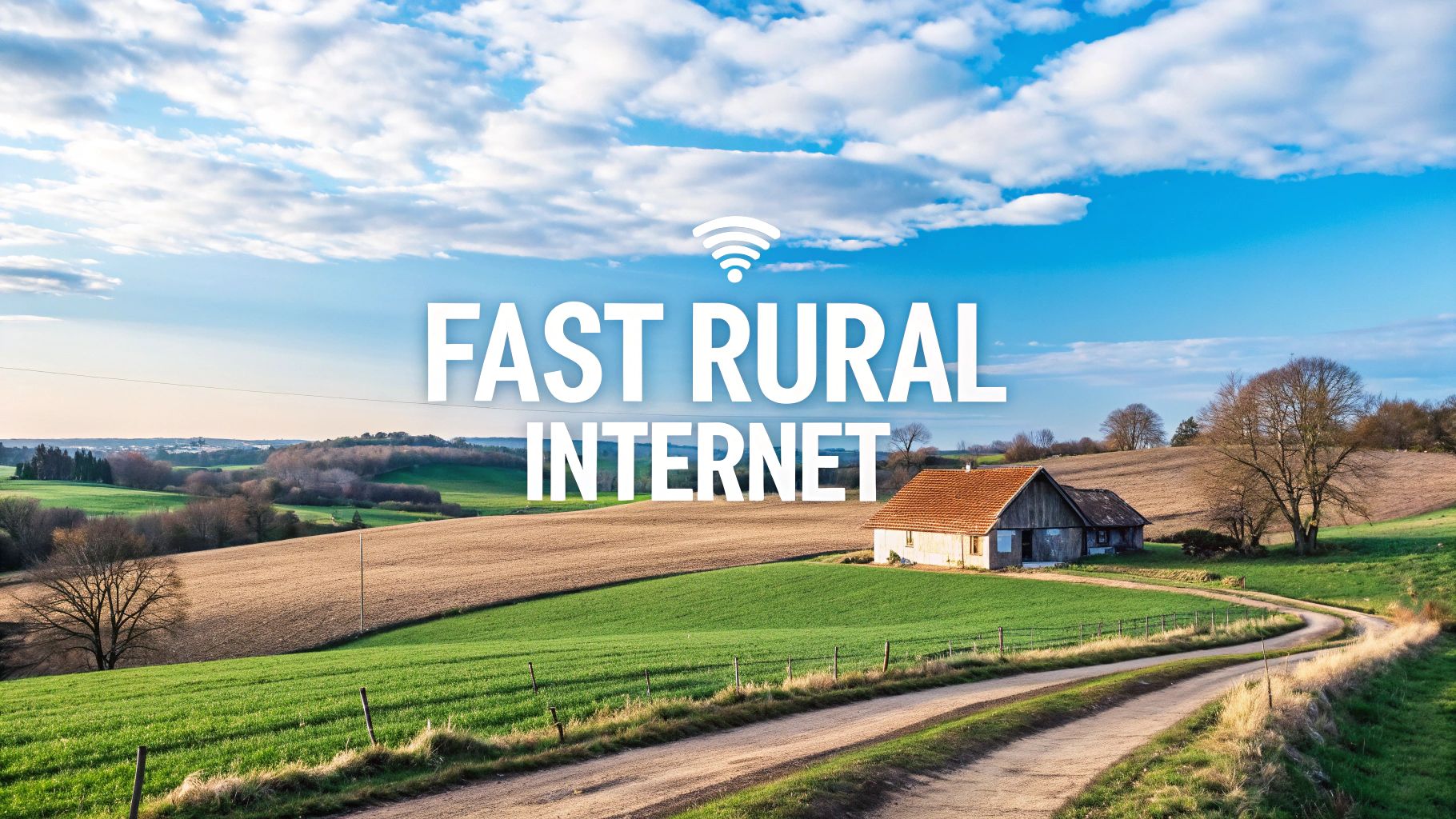

· By James
7 Rural Internet Providers: Get Fast Rural Internet in 2025
Need for Speed in the Country
Slow internet holding you back in rural America? This listicle provides seven solutions for fast rural internet access, helping you stay connected whether you're working remotely, streaming, or simply browsing. We'll cover key details about SwiftNet Wifi, Starlink, Viasat, T-Mobile Home Internet, HughesNet, Verizon LTE Home Internet, and Rise Broadband, offering a variety of options to meet your needs and budget. Find the speed and reliability you need, no matter your location.
1. SwiftNet Wifi
SwiftNet Wifi offers a high-speed 5G internet solution specifically designed for those seeking fast rural internet access, including RV travelers and residents of rural communities. This service aims to bridge the digital divide by bringing reliable connectivity to areas often overlooked by traditional internet providers. Whether you're working remotely from your RV, running a home-based business in a rural area, or simply need a dependable connection for streaming and communication, SwiftNet Wifi promises to deliver.
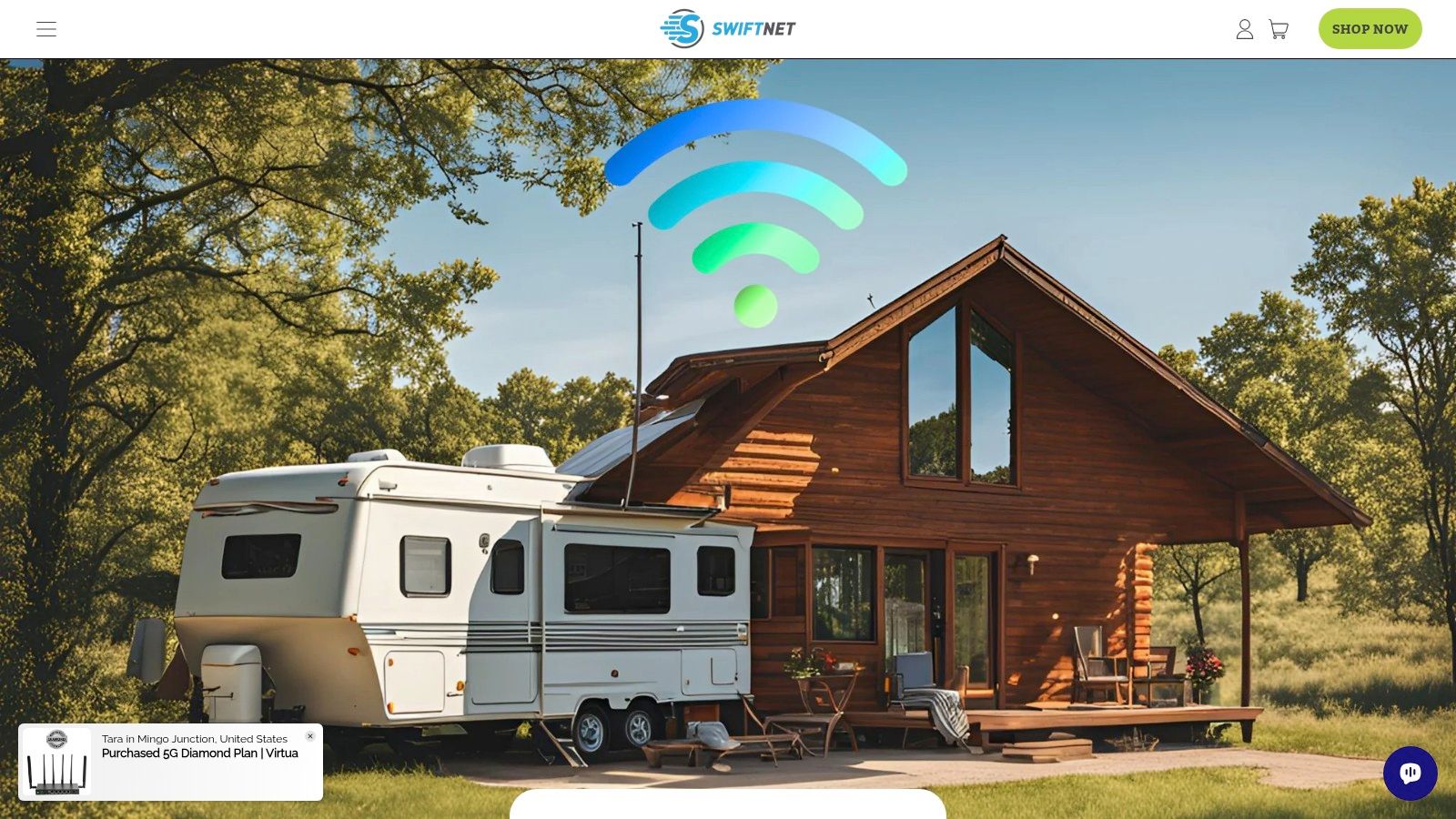
One of the key advantages of SwiftNet Wifi is its focus on mobility and flexibility. For RV travelers, this translates to seamless internet access on the go, eliminating the hassle of searching for Wi-Fi hotspots or dealing with unreliable campground connections. For rural residents, it offers a viable alternative to slow DSL or satellite internet, opening up opportunities for remote work, online education, and access to online entertainment. Learn more about SwiftNet Wifi for specific details on their services and coverage areas.
While specific pricing and technical requirements are not readily available on the main website, their focus on 5G technology suggests the potential for significantly faster speeds compared to older cellular technologies. This makes it a compelling option for those who require fast rural internet for bandwidth-intensive activities like video conferencing, large file transfers, and online gaming. It's worth noting that actual speeds can vary depending on location and network congestion.
Pros:
- Targeted towards rural areas and RV travelers: Addresses the specific needs of those often underserved by traditional internet providers.
- 5G technology: Offers the potential for high-speed internet access.
- Mobility and flexibility: Enables internet access on the go for RV users.
Cons:
- Limited information on pricing and technical requirements: Makes it difficult to compare directly with other providers.
- Performance dependent on 5G availability: 5G coverage can be patchy in some rural areas, potentially affecting service reliability.
SwiftNet Wifi earns its place on this list by offering a targeted solution for a specific problem: fast rural internet. While further information on pricing and technical details would enhance transparency, its focus on 5G and mobility positions it as a promising option for those seeking reliable connectivity beyond the reach of fiber optic cables. Visit the SwiftNet Wifi website to learn more and explore their offerings.
2. Starlink
For those seeking fast rural internet, Starlink, developed by SpaceX, presents a compelling solution. It leverages a network of low Earth orbit (LEO) satellites to deliver broadband internet to even the most remote corners of the globe, making it a viable option for RV travelers, rural homeowners, and remote workers seeking reliable connectivity. This technology bypasses the need for traditional ground-based infrastructure like fiber optic cables, opening up a world of possibilities for those living and working beyond the reach of conventional internet service providers. Starlink offers speeds significantly faster than traditional satellite internet, often rivaling or even surpassing DSL and some cable connections, making it a true contender in the quest for fast rural internet.
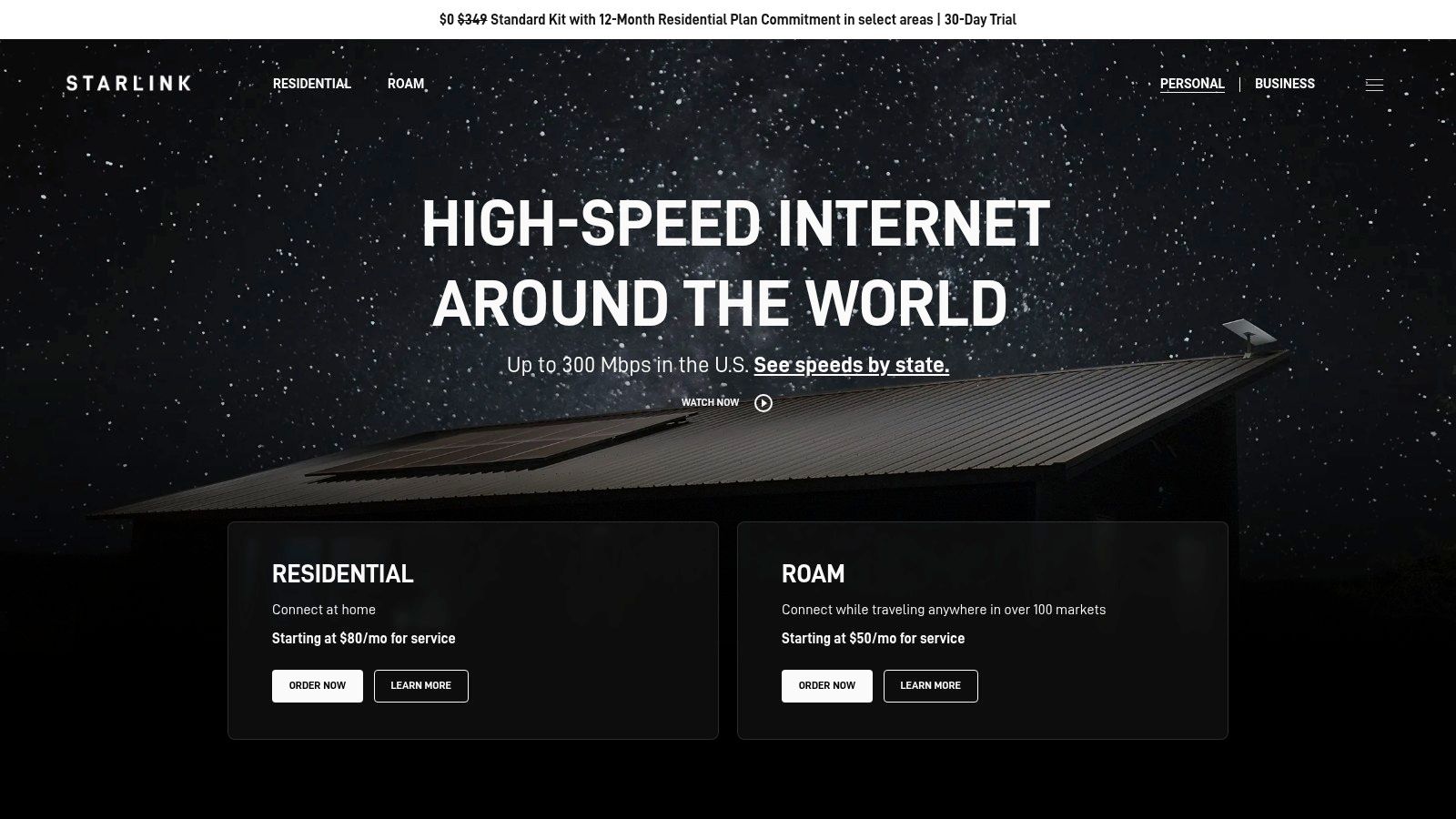
Starlink's low Earth orbit satellites are the key to its performance advantage. This drastically reduces latency, the delay you experience between sending a request and receiving a response, to a range of 20-40ms. This low latency makes activities like online gaming, video conferencing, and general web browsing much smoother and more responsive compared to traditional geostationary satellite internet, which can suffer from latency issues exceeding 500ms. With download speeds of 50-200+ Mbps and upload speeds of 10-20+ Mbps, Starlink provides sufficient bandwidth for demanding tasks like streaming high-definition video, downloading large files, and participating in online meetings. Most residential plans come with no data caps, allowing for unrestricted internet usage, a significant benefit for those who rely heavily on the internet for work or entertainment.
Setting up Starlink is designed to be user-friendly. The self-install kit includes everything you need, including the Starlink dish (terminal), a router, and mounting hardware. The dish needs a clear view of the sky to communicate with the satellites, and the Starlink app guides users through the installation and setup process, making it relatively straightforward. However, finding the optimal placement for the dish might require some experimentation.
While Starlink offers a significant leap forward for fast rural internet, it's important to be aware of the costs and potential drawbacks. The upfront equipment cost is currently $599, and the standard residential service costs $120 per month. This is a higher initial investment than some other internet options. Additionally, service can be affected by severe weather conditions like heavy snow or thick cloud cover. While the network is constantly expanding and improving, users in some areas might occasionally experience brief outages as satellite coverage continues to develop.
Key Features & Benefits:
- Low Latency: LEO satellite technology significantly reduces latency compared to traditional satellite internet.
- High Speeds: Experience download speeds of 50-200+ Mbps and upload speeds of 10-20+ Mbps.
- No Data Caps: Enjoy unrestricted internet usage on most residential plans.
- Easy Self-Installation: The kit includes everything you need and the app guides you through setup.
- Global Coverage: Starlink aims to provide service worldwide, making it ideal for travelers.
Pros:
- Available in remote areas where other options are limited.
- Significantly lower latency than traditional satellite internet.
- No contracts required.
Cons:
- Higher upfront equipment cost.
- Monthly cost is higher than some other options.
- Service can be affected by weather.
Website: https://www.starlink.com/
Starlink earns its spot on this list because it offers a practical and increasingly reliable solution for fast rural internet, connecting previously underserved communities and individuals with high-speed connectivity. For those in rural areas, RVs, or remote locations where traditional internet options are unavailable or inadequate, Starlink represents a significant step towards bridging the digital divide.
3. Viasat
For those seeking fast rural internet, Viasat offers a viable satellite-based solution, particularly for those in areas where wired connections are unavailable. Reaching homes and businesses across the US, Viasat leverages geostationary satellites to deliver broadband internet access. This makes it an attractive option for RV travelers, RV owners, and those living in remote areas without fiber optic infrastructure. While its availability is a strong advantage, it’s crucial to understand the trade-offs associated with satellite internet technology, especially concerning latency.
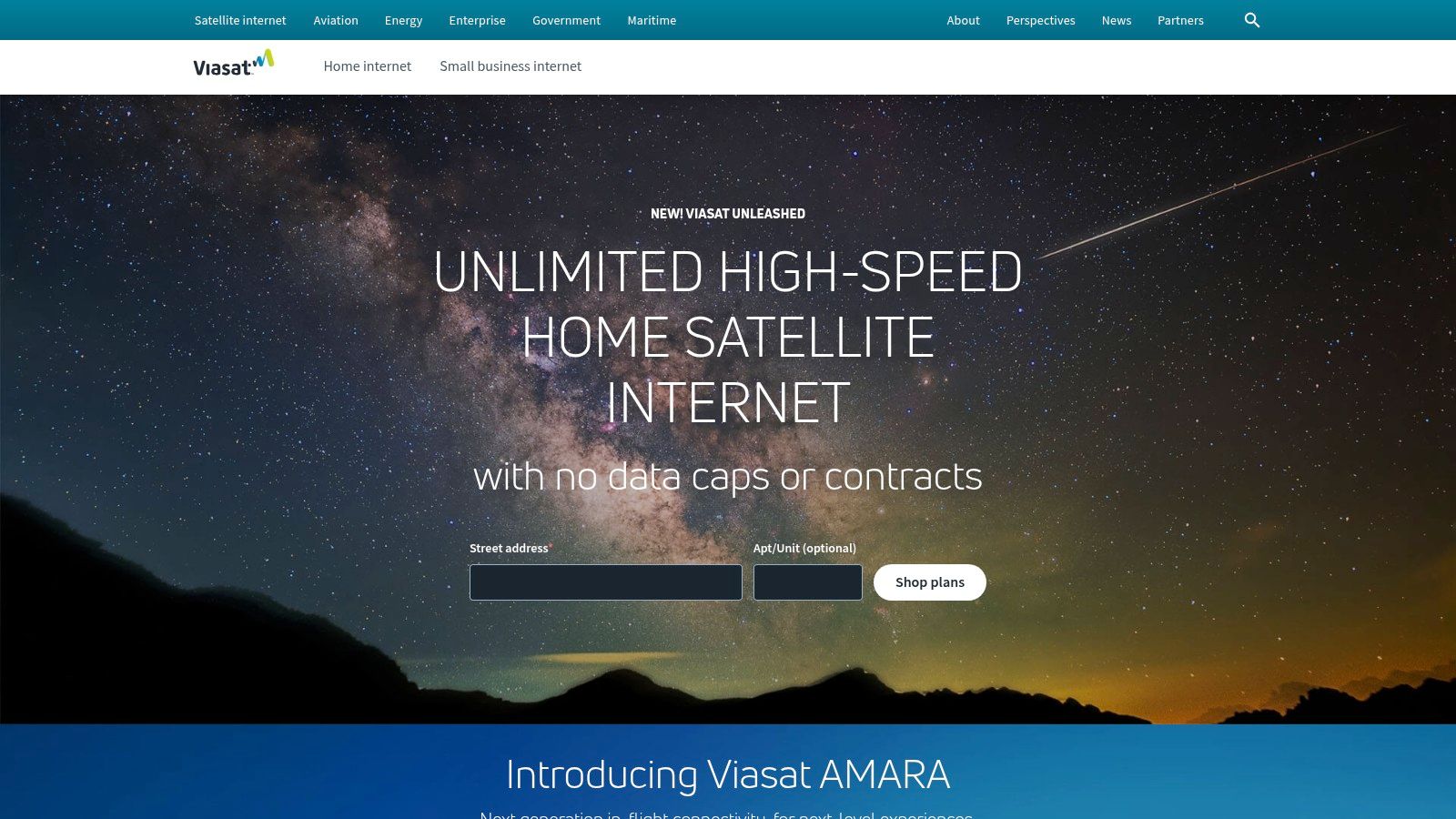
Viasat offers several different plans with varying download speeds and data allowances, catering to different needs and budgets. While they advertise speeds up to 100 Mbps in select areas, it's important to check availability at your specific location as speeds can vary considerably. Most plans operate with a "soft" data cap. This means that you won’t be cut off after exceeding your allowance, but your speeds may be prioritized lower than other users during periods of network congestion. For those who work online remotely or rely heavily on data-intensive applications, opting for a higher-tier plan is advisable.
Viasat shines in its widespread availability across rural America, making it a good option where other fast rural internet solutions fall short. The included professional installation simplifies setup, and the built-in WiFi router in the provided equipment streamlines the process further. For people living in rural areas or traveling in RVs, this ease of setup is invaluable. Bundle options with DIRECTV can also provide a cost-effective solution for bundled entertainment and internet services.
However, Viasat's reliance on geostationary satellites introduces higher latency (600-800ms) compared to ground-based or low-earth orbit (LEO) satellite internet options like Starlink. This high latency can significantly impact real-time applications like video conferencing, online gaming, and other activities requiring instantaneous feedback. While suitable for general browsing, streaming, and email, users engaging in these latency-sensitive applications may experience noticeable delays.
Price increases after the promotional period are a common concern, as are the 2-year contracts with early termination fees. Be sure to factor in the long-term cost and read the fine print before committing to a contract. Additionally, service quality can degrade during peak usage hours due to network congestion, impacting speed and reliability.
Pros:
- Widely available in rural areas
- Higher data allowances than many competitors
- No hard data caps (soft thresholds with prioritization)
- Bundle options with DIRECTV
- Professional installation included
Cons:
- Higher latency (600-800ms) affects real-time applications
- Price increases after promotional period
- 2-year contracts with early termination fees
- Service quality can degrade during peak usage hours
Website: https://www.viasat.com/
Viasat earns its spot on this list by providing a readily accessible solution for fast rural internet, particularly where other options are limited. While the higher latency may be a deterrent for some, its broad availability and relatively high data allowances make it a worthwhile consideration for those seeking a dependable internet connection in remote locations. Be sure to weigh the pros and cons carefully and consider your specific internet usage needs before making a decision.
4. T-Mobile Home Internet
For those seeking fast rural internet, T-Mobile Home Internet offers a compelling solution, particularly if you live or travel in an area underserved by traditional wired providers. Leveraging T-Mobile's extensive 4G LTE and 5G cellular networks, this fixed wireless service provides an alternative for RV travelers, RV owners, remote workers, and rural residents struggling with limited internet options. It earns its spot on this list by offering a simple, no-contract solution with unlimited data, making it a strong contender for fast rural internet access.
T-Mobile Home Internet bypasses the need for cable or fiber optic installations, making it ideal for those living in rural locations where these infrastructures are often lacking. The service utilizes a provided Wi-Fi gateway device for easy self-installation, eliminating the need for a technician visit. Simply plug in the gateway, follow the setup instructions, and you're online. This plug-and-play functionality makes it particularly appealing for RV travelers who frequently change locations and need a quick and easy internet setup. Learn more about T-Mobile Home Internet
With a flat-rate pricing of $50/month with autopay, you get unlimited data with no caps or throttling. This predictable cost makes budgeting easy and removes the anxiety of overage charges. For remote workers or digital nomads who rely heavily on the internet, unlimited data is crucial for maintaining productivity without worrying about data limits.
Features and Benefits:
- Utilizes T-Mobile's 4G LTE and 5G networks: This allows for broad coverage, especially in rural areas with decent cellular reception.
- Unlimited Data: Enjoy uninterrupted streaming, downloading, and browsing without data caps or speed throttling.
- No Annual Contracts: Flexibility to change plans or providers as needed without penalty.
- Simple Self-Installation: The provided gateway simplifies setup, eliminating the need for professional installation.
- Flat-rate Pricing: Predictable monthly cost with no hidden fees.
Pros:
- Simple, consistent pricing with no hidden fees.
- No equipment costs (gateway included).
- No data caps or throttling.
- Easy setup without professional installation.
Cons:
- Coverage limited to areas with a strong T-Mobile cellular signal. Performance depends on tower proximity and congestion. Check coverage maps carefully before committing.
- Performance can vary based on tower congestion and distance. Your actual speeds might be lower than advertised, especially during peak usage times.
- Lower priority than mobile customers during network congestion. During times of high network traffic, mobile users are prioritized, which could impact home internet speeds.
- Not available in all rural areas. While beneficial for many rural locations, T-Mobile's cellular network doesn't cover every area.
Technical Requirements:
- A strong T-Mobile cellular signal at your location.
T-Mobile Home Internet stands out for its simplicity, affordability, and unlimited data. If you're in a rural area with sufficient T-Mobile coverage, it provides a viable solution for fast internet access. However, remember to verify coverage and be aware of potential performance fluctuations based on network conditions. Visit the T-Mobile Home Internet website to check availability and learn more.
5. HughesNet
For those seeking fast rural internet access in even the most remote corners of the continental US, HughesNet is a viable option. As one of America's oldest satellite internet providers, they offer nationwide coverage through geostationary satellites. This makes HughesNet a solution worth considering for RV travelers, rural homeowners without fiber optic access, and remote workers who need a reliable connection regardless of their location. HughesNet prioritizes consistent connectivity, even in challenging environments, rather than blazing-fast speeds.
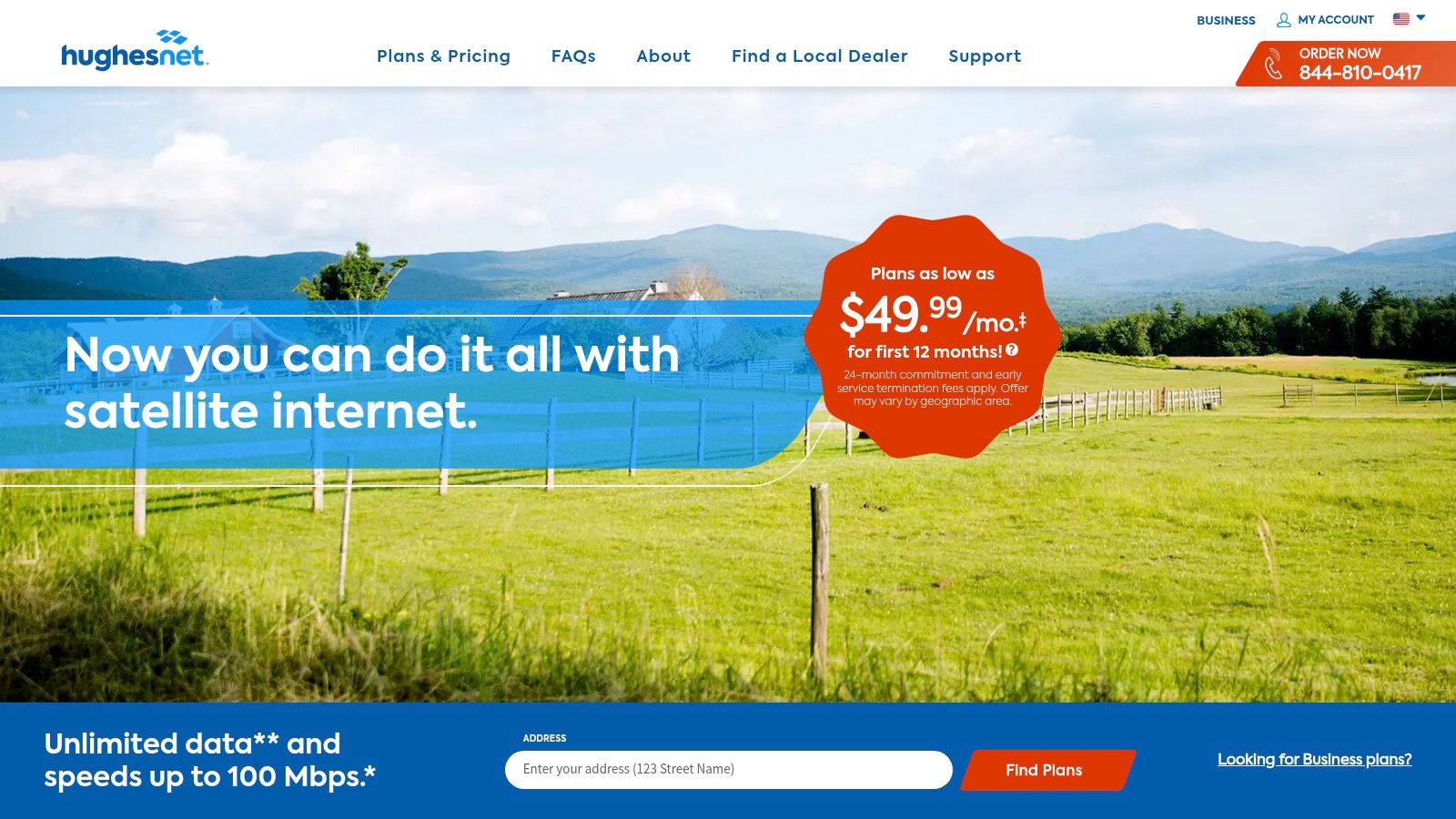
All HughesNet plans offer a consistent 25 Mbps download speed, differentiating themselves through varying monthly data allowances, ranging from 15 GB to 100 GB. This allows users to choose a plan that best fits their data consumption needs. While 25 Mbps is a significant improvement over dial-up or some other limited rural options, it's essential to understand that satellite internet inherently has higher latency (around 600+ ms) compared to cable or fiber. This high latency can impact real-time applications like online gaming and video calls. However, for everyday tasks like browsing, email, and streaming (within your data allowance), HughesNet provides a reliable connection where other fast rural internet options might be unavailable.
A valuable feature for those who can schedule their heavier internet usage is the "Bonus Zone," offering an additional 50 GB of data during off-peak hours (2 am-8 am). This can be incredibly useful for downloading large files, updating software, or backing up data without impacting your daytime data allowance. HughesNet also includes built-in Wi-Fi in their equipment and offers an optional security suite for added protection. Setting up HughesNet requires professional installation due to the satellite dish, and it's important to ensure a clear view of the southern sky.
Pros:
- Consistent 25 Mbps speeds: Provides a stable connection for general internet use in most conditions.
- Truly nationwide availability: Reaches areas other providers can't, making it ideal for RV living and remote locations.
- No hard data caps: Speeds are reduced after your allowance, but you can still access the internet.
- 24/7 technical support: Assistance is available around the clock for troubleshooting and support.
Cons:
- High latency: Impacts real-time applications like gaming and video conferencing.
- Relatively expensive per GB: Data allowances can be restrictive and costly compared to other internet types.
- Two-year contracts with early termination fees: Requires a long-term commitment.
- Significantly reduced speeds after data allowance: Speeds drop to 1-3 Mbps, impacting usability.
Website: https://www.hughesnet.com/
HughesNet earns its place on this list because it brings fast rural internet access to areas where other technologies simply can't reach. While it may not be the best option for heavy gamers or those who require low latency, it offers a lifeline for individuals and families in remote areas seeking a reliable connection for everyday internet use. Be sure to carefully consider your data usage needs and budget before committing to a plan.
6. Verizon LTE Home Internet
For those seeking fast rural internet access within Verizon's coverage area, Verizon LTE Home Internet offers a compelling fixed wireless solution. Leveraging Verizon's expansive 4G LTE network, this service bypasses the need for traditional cable or fiber optic connections, making it a viable option for many rural homes. It delivers typical download speeds of 25-50 Mbps, sufficient for streaming, video conferencing, and general internet browsing. However, remember that actual speeds depend on factors such as local tower capacity, signal strength, and network congestion. This makes it an attractive option for RV travelers, rural residents, and remote workers who prioritize reliable connectivity.
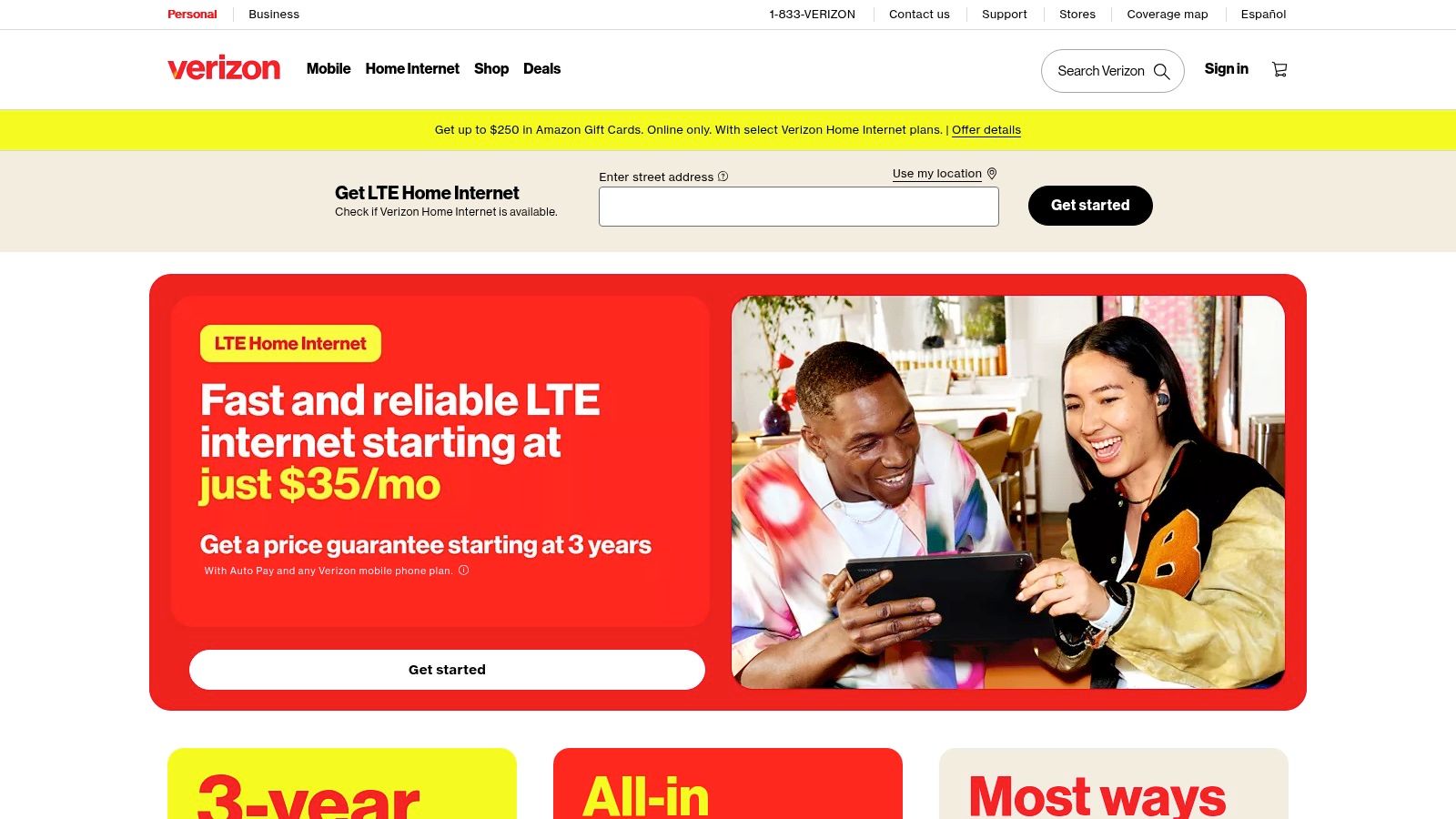
One of the key advantages of Verizon LTE Home Internet is its unlimited data plan. Unlike some satellite internet providers, there are no hard data caps to worry about, allowing users to stream, download, and browse freely. This is particularly beneficial for households with multiple users or those who rely heavily on data-intensive applications. The service also boasts a simple self-installation process using the provided LTE Home Router, eliminating the need for technician visits and simplifying setup for even less tech-savvy users. No annual contracts are required, providing flexibility for users who may have changing needs. This flexibility makes it particularly attractive to RV owners who may only need internet access seasonally.
For remote workers and digital nomads, Verizon LTE Home Internet can offer a more consistent and reliable connection compared to mobile hotspots, though performance will still be subject to network congestion and signal strength. The simple pricing structure of $60/month (or $40/month for existing Verizon mobile customers) is also appealing. No equipment purchase is necessary, as the LTE Home Router is included with the service.
However, there are limitations. Availability is restricted to areas with strong Verizon LTE coverage. Users located further from cell towers or obstructed by terrain or buildings may experience reduced speeds. While offering a good solution for fast rural internet in many locations, it's crucial to verify coverage availability at your specific location before committing to the service. Consider using a signal strength app or contacting Verizon directly to confirm coverage quality. If you live in a very remote area or experience frequent network congestion with your Verizon mobile phone, this solution may not be the best option. Compared to emerging 5G home internet options, the 4G LTE speeds might feel limiting in the future, especially for bandwidth-intensive tasks.
Key Features and Benefits:
- Utilizes Verizon's 4G LTE Network: Leverages existing infrastructure for broad coverage.
- Typical Speeds of 25-50 Mbps: Sufficient for most online activities.
- Unlimited Data: No data caps or overage charges.
- Self-Installation: Easy setup with provided LTE Home Router.
- No Annual Contracts: Flexible service terms.
- Competitive Pricing: Simple and predictable monthly costs.
Implementation Tips:
- Check Coverage: Verify service availability at your specific location.
- Optimal Router Placement: Place the router near a window or in an open area for best signal reception.
- Consider an External Antenna: In areas with weak signal, an external antenna may improve performance.
Visit the Verizon LTE Home Internet website for more information.
7. Rise Broadband: Fast Rural Internet Without the Satellite Lag
For RV travelers, remote workers, and rural residents struggling with slow internet speeds, finding reliable connectivity can feel like searching for the proverbial needle in a haystack. Fiber optic internet often remains elusive in these areas, leaving satellite internet as the default – an option notorious for lag and susceptibility to weather disruptions. Rise Broadband presents a compelling alternative for fast rural internet access in select areas, leveraging fixed wireless technology to bridge the digital divide.
Rise Broadband is one of America's largest fixed wireless internet providers, specifically focusing on underserved rural and suburban communities. Unlike satellite internet, Rise uses ground-based towers to transmit signals directly to a receiver installed at your home or RV. This terrestrial approach offers a significant advantage: lower latency. While satellite internet often suffers from high latency (delays) making video calls and online gaming frustrating, Rise Broadband boasts latency comparable to DSL or cable internet, typically in the 30-60ms range. This makes it a viable option for activities that require real-time responsiveness.
Speeds typically range from 25-50 Mbps, sufficient for streaming, video conferencing, and general internet browsing. Some locations can even access speeds up to 100 Mbps, placing it firmly in the "fast rural internet" category. Learn more about Rise Broadband to understand their coverage map and available plans.
Features and Benefits:
- Fixed Wireless for Lower Latency: Experience smoother online gaming, video calls, and general browsing with significantly reduced lag compared to satellite internet.
- Speed Options: Choose from a variety of plans with speeds ranging from 25 Mbps to 100 Mbps depending on your location.
- Flexible Data Plans: Many plans offer unlimited data, eliminating worries about overage charges, a common concern for remote workers and heavy internet users.
- Local Support: Rise Broadband provides local customer service in its service regions, offering a more personalized support experience.
- No Contracts (in most cases): Enjoy the flexibility of month-to-month service without being locked into long-term contracts.
Pros and Cons:
Pros:
- Significantly lower latency than satellite internet.
- More stable performance in inclement weather than satellite.
- Local customer service.
- No contracts required for most plans.
Cons:
- Limited geographical coverage, primarily in the Midwest and Western United States.
- Requires a clear line-of-sight between your location and a Rise Broadband tower.
- Installation fees usually apply, typically involving a professional technician setting up the receiver.
- Service quality and available speeds can vary considerably depending on location and tower capacity.
Implementation and Setup:
Rise Broadband requires professional installation, ensuring the receiver is properly aligned with the nearest tower for optimal signal strength. Contact Rise Broadband to determine availability in your area and schedule an installation appointment. While pricing details aren't readily available online and vary by location, be sure to inquire about installation costs and available data plans during your initial contact.
Why Rise Broadband Deserves its Place on the List:
Rise Broadband offers a compelling solution for fast rural internet by providing a practical alternative to slow DSL and laggy satellite internet. Its focus on fixed wireless technology delivers a noticeable improvement in latency, making it suitable for a wider range of online activities. While the limited geographical coverage is a drawback, for those within its service area, Rise Broadband can be a game-changer, connecting rural communities and enabling remote work and entertainment possibilities. Visit their website for more information: https://www.risebroadband.com/
Fast Rural Internet: 7 Provider Comparison
| Provider | Implementation Complexity 🔄 | Resource Requirements 💡 | Expected Outcomes ⭐📊 | Ideal Use Cases 💡 | Key Advantages ⚡ |
|---|---|---|---|---|---|
| SwiftNet Wifi | Low – standard 5G setup | Moderate – requires 5G coverage | High-speed 5G connectivity | Rural areas, RV travelers | High speed 5G for mobility |
| Starlink | Moderate – satellite dish installation | High – upfront hardware cost ($599) | High speed (50-200+ Mbps), low latency | Remote/rural with clear sky view | Global coverage, low latency |
| Viasat | High – professional installation | High – contracts and equipment fees | Speeds up to 100 Mbps but high latency | Rural homes/businesses needing wide coverage | Widest US rural coverage, high data allowance |
| T-Mobile Home Internet | Low – easy self-installation | Low – gateway included, no equipment cost | Moderate speed (35-115 Mbps), unlimited data | Rural with strong T-Mobile cellular signal | Simple pricing, unlimited data |
| HughesNet | High – satellite dish and contracts | High – equipment + 2-year contracts | Steady 25 Mbps speeds, data thresholds | Very remote US locations | Nationwide availability, consistent speed |
| Verizon LTE Home Internet | Low – self-installation | Low – equipment included | Moderate speeds (25-50 Mbps), unlimited data | Rural with Verizon LTE coverage | Unlimited data, simple pricing |
| Rise Broadband | Moderate – professional installation | Moderate – installation fees apply | Speeds 25-100 Mbps, low latency | Rural/suburban areas in Midwest/West | Lower latency than satellite, local support |
Connecting the Countryside
Finding reliable, fast rural internet can feel like searching for a needle in a haystack. This article has explored seven key players in the rural internet market: SwiftNet Wifi, Starlink, Viasat, T-Mobile Home Internet, HughesNet, Verizon LTE Home Internet, and Rise Broadband. Each option offers unique features, pricing structures, and data limits, catering to different needs and budgets. Whether you're a full-time RVer, a remote worker, or simply a rural resident tired of slow speeds, understanding these differences is crucial to finding the perfect connection.
Key takeaways include the importance of considering your data usage, location availability, and budget. Starlink, for example, offers impressive speeds via satellite, while T-Mobile and Verizon leverage existing cell networks. Viasat and HughesNet also provide satellite internet, but with varying data caps. Rise Broadband utilizes fixed wireless, a solid option where available. Finally, SwiftNet Wifi presents a specialized solution designed to aggregate multiple connections for robust and consistent performance.
Choosing the right tool for fast rural internet depends on your individual circumstances. If you need high speeds with generous (or unlimited) data and are willing to invest in equipment, Starlink might be your best bet. If you're on a tighter budget, explore options like T-Mobile Home Internet or Verizon LTE Home Internet, keeping in mind potential data limitations. For areas with limited infrastructure, satellite internet providers like Viasat and HughesNet can fill the gap. Having fast internet is only half the battle. To ensure you're getting the most out of your rural internet connection, it's crucial to optimize your website's performance. A slow website can negate the benefits of fast internet. You can test your website speed using various online tools, like this helpful guide: website speed test.
No matter your situation, research is key. Compare plans, check availability in your area, and read reviews before committing to a provider. With careful planning and the right tools, you can finally experience the freedom and productivity of fast rural internet.
Ready to experience a seamless and reliable internet connection no matter where your travels take you? Check out SwiftNet Wifi, designed specifically for the challenges of rural internet access by combining multiple connections for ultimate performance and redundancy.

